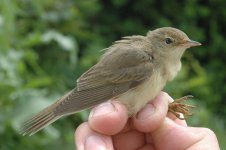hannu
Well-known member
I was ringing in last night and I noticed that main part of night singers have stopped their singing. I catched only 4 Blyth's Reed Warblers. Also I found Icterina Warbler, which was nice observation too. I heard only one Thrush Nightingale. Funny thing happened last night, when police came to ask on my doing. Mosquitos caused displeasure to me very much and now itching to the hands and head.
Total ringing sum now:
Blyth's Reed Warbler 45
Marsh Warbler 5
River Warbler 2
Grasshopper Warbler 1
Sedge Warbler 2
Pied Flycatcher 1
and control:
Pied Flycatcher 1
Total ringing sum now:
Blyth's Reed Warbler 45
Marsh Warbler 5
River Warbler 2
Grasshopper Warbler 1
Sedge Warbler 2
Pied Flycatcher 1
and control:
Pied Flycatcher 1
Last edited:





